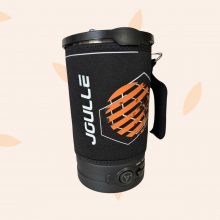
Most Americans believe that if a chemical is in their cosmetics, their coat, or their couch, someone is making sure it’s safe for their health. In reality, little toxicity information or regulation is required for 80,000 industrial chemicals used in commerce in the United States.
– Tackling Toxics by Arlene Blum PhD, Director Green Science Policy Institute
Camping is one of the best ways to escape the hustle and bustle of city life, unplug and relax. When planning a camping trip, most people focus on how exciting the experience will be, the nature and wildlife they’ll get to see, and the activities they’ll do, like hiking, biking, mountain climbing, kayaking, etc.
People usually aren’t thinking about the hidden, potentially dangerous toxins permeating the fabric of their tent. And rightly so! Who wants to think about those things, ever? One way to make your camping trip healthier for both your mind and body is to use a tent made with non-toxic tent materials, free of chemicals like fire retardants, PFCs, and PFAs.
Not all tents are created equal when it comes to how they’re made and the potential impact tent materials can have on our health and the environment. Thus, there is a growing movement in the outdoor community to create and promote non-toxic tents that prioritize human and environmental health & safety.
Key Takeaways:
- PFCs, VOCs and PFAs are persistent pollutants found in many manufactured products, including camping tents.
- Exposure to PFCs, VOCs and PFAs can cause serious health issues including cancer, respiratory problems, hormone imbalances and neurological impairments.
- Choosing a non-toxic tent made without these chemicals can help reduce your exposure, primarily through off-gassing and touching fabrics.
The Importance of Non-Toxic Tent Materials
Historically, tents have usually been made with some fairly toxic materials. This is not to say that your tent is going to immediately poison you or send you to the hospital, but it may contain some toxic additives like fire retardants, PFCs, and PFAs.
These chemicals get “off-gassed” into the air when you sleep inside the shelter, especially for new tents. This is where the main dangers are created for humans, because you spend so much time sleeping inside the tent and breathing the air, you can’t avoid inhaling these substances.
Additionally, using these chemicals in the production and disposal process contributes to environmental pollution and resource depletion, as these chemicals eventually make their way into natural environment.
Non-toxic tents are made with as few harmful chemicals as possible, in order to minimize your exposure while also reducing the ecological footprint to create the tent. By choosing a non-toxic tent, you can enjoy the great outdoors with the knowledge that you’re taking steps to protect both your health and the environment.
Benefits of Non-Toxic Tent Materials
Non-toxic tents offer several potential benefits in terms of health, safety, environmental sustainability, durability and performance.
Health and Safety
Non-toxic tents are made with as few chemicals as possible, including volatile organic compounds (VOCs), perfluorinated compounds (PFCs), and perfluoroalkyl substances (PFAs) and flame retardants. Scientists at the National Institute of Environmental Health Sciences and the Center for Disease Control have determined that these chemicals can be dangerous to humans.
Environmental Sustainability
The fact that non-toxic tents are made without toxic chemicals means they are less damaging to the environment because these substances are not released into the air, soil or groundwater. In addition, non-toxic tents are constructed with more sustainable materials, including cotton, hemp, and recycled materials.
Durability and Performance
Non-toxic tents are constructed to have the same level of performance as regular tents so that they can endure different types of weather and provide the same level of comfort and protection.
For example, the tent brands Big Agnes and NEMO do not have flame retardants or PFCs, but are also considered some of the best brands on the market for backpacking and ultralight tents. They have won a number of prestigious awards for the high quality of their products, including the Backpacker’s Fall 2020 Editor’s Choice Award and the 2018 Popular Science Award.
Examples of Non-Toxic Tent Materials
Natural Fabrics
Natural fabrics are a popular choice for non-toxic tents because they are sustainable, breathable, and durable.
Organic Cotton Canvas
Organic cotton is a renewable crop that can be grown without synthetic fertilizers or pesticides. It’s also breathable and allows air to easily circulate within the tent. This helps regulate humidity and temperature, and makes the tent more comfortable and livable.
- Lucky Sheep makes an Organic Canvas Tent that’s coated with beeswax for waterproofing.
- Alpkit makes a tent called “Frejus” that’s crafted from organic polycotton canvas that’s also naturally waterproof.
Hemp
Hemp is a sustainable crop because grows quickly and it requires minimal water and no pesticides to grow, making it an eco-friendly alternative. it’s also strong and durable, and similar to cotton, hemp is breathable and allows air flow throughout the tent.
Bamboo
Bamboo crops grows easily and quickly, without the need for extensive water or pesticides. Bamboo fabrics offer excellent breathability, allowing for proper ventilation inside the tent. This helps prevent moisture buildup, ensuring a comfortable camping experience.
Recycled and Upcycled Tent Materials
Recycled and upcycled materials are a popular choice for crafting non-toxic tent fabric because they’re inherently weather resistant and lightweight, in addition to promoting resource conservation.
Recycled Polyester
Recycled polyester, also known as rPET, is created from recycled plastic bottles. Using this as an alternative tent fabric to conventional polyester helps reduce plastic waste and the consumption of non-renewable resources like petroleum. Recycled polyester also has similar strength and water resistance to conventional polyester.
- Nemo’s OSMO tent fabric is a Nylon / Polyester Composite that’s engineered to be 4X more water resistant, 3X less stretchy when wet and more durable than conventional tent fabrics. OSMO fabric is also @bluesign approved and 100% free of flame-retardants and PFA waterproofing chemicals.
| Preview | Product | Rating | Price | |
|---|---|---|---|---|
| | NEMO Aurora 2P Tent (Green Nova) & Footprint | $283.08 | Buy on Amazon | |
| | Nemo Dagger OSMO Ultralight Backpacking Tent, Birch Bud/Goodnight Gray, 2 Person | 29 Customer Reviews | $479.00 | Buy on Amazon |
| | Nemo Aurora Highrise, 3 Season, Family, Car Camping Tent, Atoll/Oasis, 4P | $399.95 | Buy on Amazon |
Upcycled Materials
Upcycled materials are leftover fabrics or materials that would otherwise be discarded, but are instead repurposed to create a new products. Upcycled materials help reduce waste that would otherwise end up in landfills and contributes to a circular economy, where resources are reused instead of being disposed of.
Table 1 – Types of Non-Toxic Fabrics
| Material Type | Properties | Environmental Impact | Certifications/Standards |
| Cotton | Breathable, comfortable, biodegradable | Requires large amounts of water and pesticides to grow | Global Organic Textile Standard (GOTS) |
| Hemp | Durable, breathable, naturally resistant to mold and UV light | Requires less water and pesticides to grow than cotton, biodegradable | Global Organic Textile Standard (GOTS) |
| Polyester | Durable, lightweight, water-resistant | Made from non-renewable resources, not biodegradable | Bluesign, Oeko-Tex Standard 100 |
| Nylon | Durable, lightweight, water-resistant | Made from non-renewable resources, not biodegradable | Bluesign, Oeko-Tex Standard 100 |
| Canvas | Durable, breathable, insulating | Made from natural fibers, biodegradable | N/A |
| Polyethylene | Durable, waterproof | Made from non-renewable resources, not biodegradable | N/A |
| Polypropylene | Durable, lightweight, water-resistant | Made from non-renewable resources, not biodegradable | N/A |
| Tencel | Breathable, moisture-wicking, biodegradable | Made from sustainably sourced wood pulp, biodegradable | Forest Stewardship Council (FSC) Certification |
| Wool | Insulating, naturally water-resistant, biodegradable | Made from natural fibers, biodegradable | Global Organic Textile Standard (GOTS) |
Non-Toxic Flame Retardants
Non-toxic flame retardants are substances designed to add fire repellency without the use of VOCs or other dangerous chemicals. Products like Flame Guardian® and Flamexx® are specifically formulated to reduce campers’ exposure to toxic chemicals, while enhancing the safety of tent fabrics. Non-toxic flame retardants are often hypoallergenic, making them suitable for individuals with sensitivities or allergies.
Table 2: Non-Toxic Flame Retardant Chemicals
| Flame Retardant Type | Properties | Environmental Impact |
|---|---|---|
| Halogen-Free inorganic Flame Retardants | Made with Aluminum and Magnesium Hydroxides | Non-Toxic, Made from Natural Minerals, Does Not Release Toxic Gases |
| Nitrogen-Based Flame Retardants | Melamine-Based | Non-Toxic in Small Amounts |
| Organophosphorus Flame Retardants | Halogen-Free, Low or Zero VOCs | Non-Toxic, Does Not Contain Harmful Chemicals |
| Clay-Based Flame Retardants | Biodegradable, Naturally Sourced | Non-Toxic |
| Cellulose-Based Flame Retardants | Plant-Based Natural Polymers | Non-Toxic |
| Alumina Trihydrate | Non-Toxic, Biodegradable | Made from natural minerals, low environmental impact |
Non-Toxic Dyes and Inks
In addition to the materials used to make the tent fabrics, it’s important to make sure that the dyes and inks used are also eco-friendly. These additives should be free of chemicals like heavy metals or carcinogens, hypoallergenic to minimize allergic reactions and biodegradable so that they break down naturally in the environment over time.
Table 3: Non-Toxic Dyes and Inks
| Dye/Ink Type | Properties | Environmental Impact | Certifications |
|---|---|---|---|
| Natural Dyes | Made from plant-based materials, biodegradable | Low environmental impact, renewable resources | Global Organic Textile Standard (GOTS) |
| Low-Impact Dyes | Synthetic dyes with lower environmental impact, biodegradable | Less water and energy used in production, fewer toxic chemicals released | Bluesign, Oeko-Tex Standard 100 |
| Water-Based Inks | Non-toxic, biodegradable | Low environmental impact, no volatile organic compounds (VOCs) | N/A |
| Soy-Based Inks | Non-toxic, biodegradable | Made from renewable resources, low environmental impact | N/A |
| UV-Curable Inks | Non-toxic, biodegradable | Low environmental impact, no VOCs | N/A |
| Digital Printing | No dyes or inks used, minimal waste | Low environmental impact, energy-efficient | N/A |
Certifications for Non-Toxic Tents

The Dangers of Conventional Tent Materials
Since our health is one of the most important things we have, it’s crucial to consider the potential dangers associated with the chemicals used to make conventional camping tent materials.
Tents, by their nature, are enclosed spaces where campers spend a significant amount of time sleeping and relaxing. Because of this confined environment, people can be exposed to higher levels of chemicals, especially in newer tents. This process is called “off-gassing”, which describes how the chemicals used in the fabric of tent materials are slowly released into the air. Prolonged exposure to off-gassing can effect your body and health over time.
Health Dangers of VOCs, PFCs and PFAs
Conventional tents often contain a variety of chemicals that can pose health and environmental risks, especially when presented in large concentrations.
Volatile Organic Compounds (VOCs) in Flame Retardants
At one time, it made sense to require flame retardants that would prevent or slow the spread of fire. But we now know those same chemicals can cause cancer. They also can affect children’s growth and brain development.
– Center 4 Research
Flame retardant chemicals include a group of various chemicals used to reduce the chance of fabrics and materials becoming flammable. The fire retardants used on tent fabric can release volatile organic compounds (VOCs) into the air.
According to research done by the National Institute of Environmental Health Sciences, VOCs are linked to a number of health problems, including endocrine and thyroid disruption, reproductive toxicity, cancer, to name a few. As a result, flame retardant chemicals have the potential to cause health problems, including breathing difficulties, skin allergies, and long-term residual effects on the reproductive system.
- Home Sweet Home? Flame Retardants in Your Home Can Harm You
- Volatile Organic Compounds: Do they present a risk to our health?
- Volatile Organic Compounds (VOCs) as Environmental Pollutants
Due in part to their chemical properties, some PFCs can remain in the environment and bioconcentrate in animals. Data from human studies suggest that some PFCs can take years to be cleared from the body.
– Environmental Protection Agency
Perfluorinated Compounds (PFCs)
Perfluorinated compounds (PFCs) are molecules constructed of carbon chains attached to fluorine atoms. Once PFCs enter the atmosphere, they are very resilient and don’t break down or degrade, which is why they are also known as “forever chemicals”. The health impacts of PFCs include toxic changes to the immune system, endocrine disruption, and organ damage.
- Polyfluorinated Compounds: Past, Present, and Future
- Toxicology of perfluorinated compounds
- Perfluorinated Chemicals (PFCs)
Perfluoroalkyl Substances (PFAs)
PFAS, short for per- and polyfluoroalkyl substances, are a group of nearly 15,000 synthetic chemicals used in different types of everyday products, including tents and other camping gear. These chemicals are are man-made and have been used in consumer products for more than 60 years.
PFAS have been found in virtually every environmental medium tested – air, water soil and food – making them among the most widely distributed contaminants known. Depending on the level of exposure, the health impacts of PFAs include damage to the immune system, elevated risk of certain cancers, and birth defects.

Environmental Dangers
In addition to the potential harm to human health, conventional tents can also have dangerous effects on the environment.
Persistence in the environment
PFCs, VOCs, and PFAs are highly persistent environmental pollutants because of their strong carbon-fluorine bonds, which make them very difficult to break down over time. This resistance means that the compounds can remain in the environment for long periods of time and easily spread across large areas.
These substances can contaminate air, soil, groundwater, watersheds, surface water sources such as rivers or ocean. In addition to contamination of ecosystems, PFCs/VOCs/PFAs may also cause secondary contamination resulting from transport along different routes (e.g., groundwater).
Contamination of food supplies is also possible when these chemicals enter farming areas through crop irrigation or contaminated soils, or they are ingested by farm animals through their feed.
Contamination of soil, water, and air
Contamination from PFCs, VOCs, and PFAs is a serious environmental problem. These hazardous substances are released through everyday industrial activities such as manufacturing processes and the burning of fossil fuels.
Although some PFAS biodegrade naturally over time, they linger in the environment for many years and can accumulate inside plants and animals with high concentrations reaching toxic levels that cause adverse health effects in humans.
Soil contamination is particularly dangerous because it can lead to direct contact with the pollutants thus increasing people’s exposure to them while water contamination threatens wildlife populations since aquatic species cannot avoid chemical absorption that eventually reaches higher tiers in food chains.
Effects on wildlife and ecosystems
PFCs, VOCs and PFAs are persistent pollutants that can contaminate soil, air, water and marine environments. These substances have been known to accumulate in the tissues of wildlife organisms and their effects on animal health is not well understood.
The presence of these contaminants has serious impacts on wildlife species and entire ecosystems across the globe. For example, the accumulation of PFAs over time can bioaccumulate in fish which may cause developmental problems or weaken immune responses to pathogens later in life.
Exposure to VOCs such as benzene affects birds’ flight abilities by damaging nerve cells within their brains; this can lead to reduced food intake in birds thus impairing breeding success rate and disrupting ecosystem balance further down the line.
Furthermore, environmental contamination caused by PFCs and other industrial wastes contain an array of chemicals with significant carcinogenic risks for humans as well as animals exposed through ingestion or inhalation gradually over time leading into long-term ill health effects for local habitats unable to be restored otherwise due to its persistence nature without immense efforts.
Certifications and standards help consumers verify the non-toxicity and sustainability of tents so that they can make informed buying choices.
MADE SAFE
MADE SAFE is more than just a certification program; it’s a promise to consumers. The rigorous certification process examines the complete product lifecycle to make sure that non-toxic materials are used at every stage, including raw materials, manufacturing, and even disposal, in addition to using independent, third-party labs to verify products.
MADE SAFE also promotes methods like sourcing materials sustainably, optimizing energy use, and minimizing waste. The certification ethos is not just about what’s in the products; it’s about how they’re made, weaving a tapestry of environmental responsibility that extends from the factory floor to the consumer’s hand.
Forest Stewardship Council (FSC) Certification
The Forest Stewardship Council (FSC) is an internationally recognized certification system that works to ensure that forests around the world are managed sustainably and responsibly, with standards set for forest management, timber harvesting, and product traceability. Products with the FSC certification come from responsibly managed timber farms, and the wood is carefully tracked and traced with a chain of custody (CoC) tracking system.
FSC certification also promotes the rights and fair labor practices of local communities and workers, including indigenous rights and people who depend on forests for their livelihoods.
Global Organic Latex Standard (GOLS)
The Global Organic Latex Standard (GOLS) certification validates that latex products are organic, sustainably produced and free from synthetic chemicals, pesticides, and genetically modified organisms (GMOs). GOLS sets criteria for the sourcing, processing, and manufacturing of organic latex, focusing on environmental responsibility and social fairness.
CertiPUR-US
CertiPUR-US certifies foam used in bedding as safe and eco-friendly without harmful chemicals. This certification guarantees that foam products are free from substances like heavy metals, formaldehyde, and phthalates.
OEKO-TEX Standard 100
The OEKO-TEX Standard 100 certification verifies that fabrics have been tested and are free from heavy metals, pesticides, formaldehyde, phthalates, and allergenic dyes.
Global Organic Textile Standard (GOTS)
The Global Organic Textile Standard (GOTS) certifies that clothing and other textiles are crafted from organic fibers, and are grown without pesticides and toxic chemicals, and that the production process is sustainable. What’s more, GOTS also ensures that the people who make these products work under safe conditions, and that they are paid a living wage. No one is forced to work, and no children are used for labor.
Bluesign®
The Bluesign® System makes sure that textiles are made using eco-friendly practices in the whole supply chain. They have strict rules about harmful substances, require transparency and traceability, and promote efficient production.
Cradle to Cradle (C2C)
Cradle to Cradle (C2C) Certification is a process that evaluates products based on their impact on the environment and society throughout their lifecycle. It’s all about promoting sustainability and designing products that are fully recyclable, reusable, or compostable, which helps to minimize waste and natural resource consumption.
Table 4: Non-Toxic Tent Certifications
| Certification Name | Description |
|---|---|
| MADE SAFE | MADE SAFE screens ingredients for known harmful chemicals such as flame retardants, heavy metals, and formaldehyde. |
| Forest Stewardship Council (FSC) Certification | FSC certification verifies that products come from responsibly managed forests. |
| Global Organic Textile Standard (GOTS) | GOTS certification verifies that products are made with organic fibers and that manufacturing is environmentally and socially responsible. |
| Global Organic Latex Standard (GOLS) | GOLS certification verifies that products are made with organic latex and that manufacturing is environmentally and socially responsible. |
| OEKO-TEX Standard 100 Certification | OEKO-TEX Standard 100 certification screens for harmful substances such as heavy metals, pesticides, and formaldehyde. |
| CertiPUR-US | CertiPUR-US screens for harmful substances in foam such as heavy metals, formaldehyde, and flame retardants. |
| Flame Retardant-Free | This certification verifies that no flame retardants were used in the manufacturing of the tent. |
Tips for Choosing a Non-Toxic Tent
Selecting non-toxic tents is crucial for a safe and eco-friendly camping experience. Follow these helpful tips to confidently choose the right non-toxic tent:
1. Research Tent Brands
Choose tent manufacturers that are committed to using non-toxic materials and sustainable practices. Research their certifications, environmental initiatives, and transparency regarding the materials used in their tents.
2. Look for Non-Toxic Certifications
Look for tents with certifications such as OEKO-TEX Standard 100, GOTS, Bluesign®, or Cradle to Cradle (C2C). These certifications ensure that the tent materials meet strict non-toxicity and environmental standards.
3. Consider Materials and Construction
Opt for tents made from natural fabrics such as cotton, hemp, or bamboo. These materials are often non-toxic, biodegradable, and sustainable.
Choose tents that incorporate recycled or upcycled materials, such as recycled polyester or repurposed fabrics, to contribute to waste reduction and resource conservation. Select tents with low-VOC coatings to minimize the release of harmful chemicals and promote better indoor air quality.
4. Verify Flame Retardant Safety
Ensure that the tent utilizes non-toxic flame retardants to maintain fire safety without compromising health. Look for tents that explicitly mention the use of non-toxic flame retardant alternatives.
5. Evaluate Dye and Ink Safety
Verify that the tent uses non-toxic dyes and inks, free from harmful chemicals. Look for certifications or statements regarding the use of environmentally friendly and skin-safe dyeing processes.
6. Assess Durability and Longevity
Evaluate the overall quality and construction of the tent. Look for reinforced seams, sturdy zippers, and reliable poles to ensure durability and longevity.
7. Consider Ethical and Sustainable Practices
Choose brands that prioritize ethical and sustainable manufacturing practices such as fair labor standards, responsible sourcing, and waste reduction.
Select tents designed for easy repair and have provisions for recycling at the end of their lifecycle, promoting a circular economy.
Resources to Learn About Non-Toxic Materials
- Organizations and Certifications:
- Environmental and Health Institutions:
- Industry Associations:
- Research Papers and Studies:
- “Toxicity of Flame Retardants” – Environmental Science & Technology
- “Chemical Emissions from Consumer Products” – Environmental Science & Technology
- Industry Publications and News:
Conclusion
In short, opting to choose a tent made with non-toxic materials helps create a safe, healthy, and eco-friendly camping experience for you, your family and friends. By understanding exactly how your camping gear is created, you can make the best decisions and select a non-toxic tent that aligns with your values and priorities.
Related Posts:






